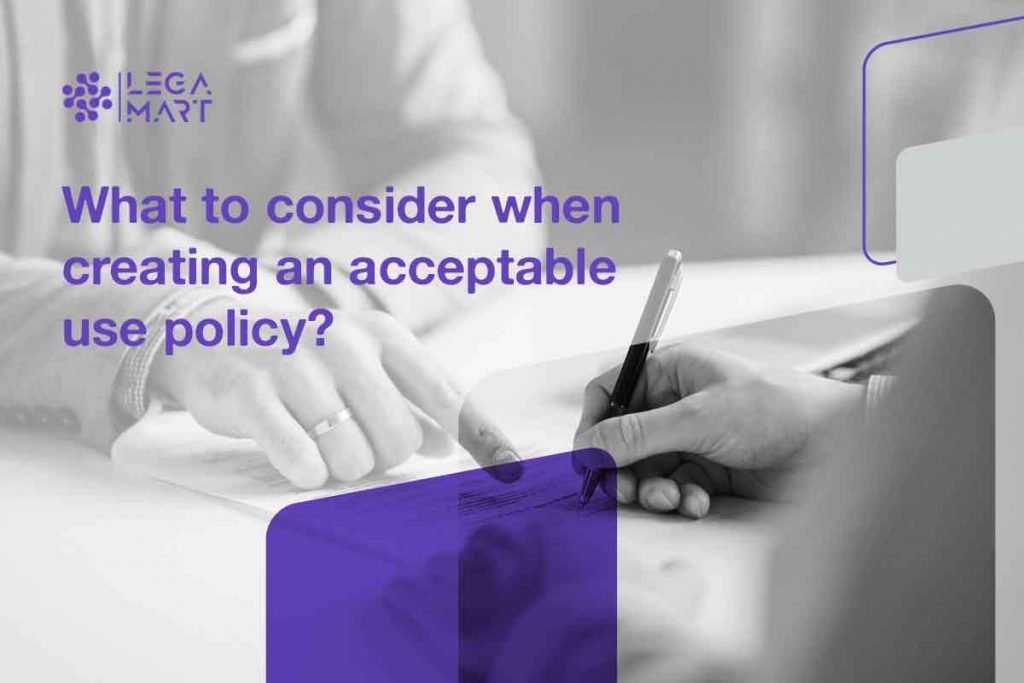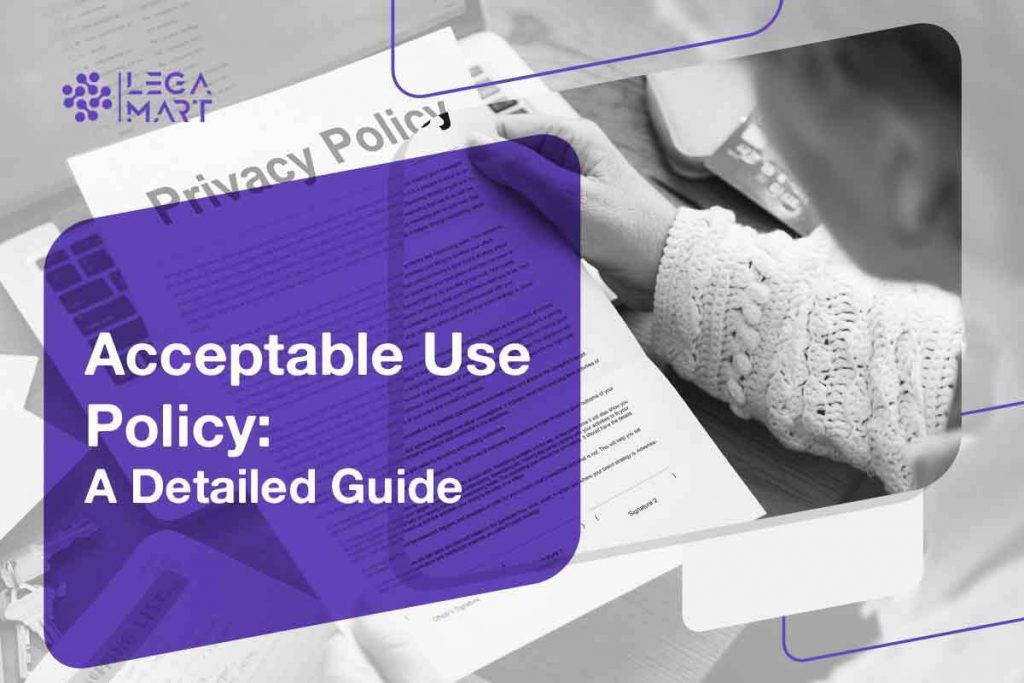Jaden created a new social media platform, but he is unsure about how he can direct its users to follow certain etiquette when using the platform and publishing content; he wants to restrain them as little as possible while making sure the platform is accessible to all ages. After much thought, he concluded that he would enable the platform to ban and remove content created by its users if they used it in a way that went against the guidelines he provided at the beginning when they created their accounts.
Jaden then proceeds to formulate the acceptable use policy for his platform and to enforce it, creating the perfect terms and conditions (t&cs), which include terms of service and terms of use agreements. This agreement provides Jaden with sufficient control over his platform to prevent people from misusing it and enforces jaden’s intentions with this platform – a free place of expression for everyone’s opinions.
What is an acceptable use policy?
An acceptable use policy, or AUP, is a set of constraints and practices that a creator or owner of a network, service or online product sets up, setting the norm for how the user uses that network, service, or online product. Without agreeing to the AUP, the user cannot use the network. Once a user agrees to the stipulated AUP, the user has to make sure that they utilize that network, service, or product according to the provisions of the policy; otherwise, the owner can remove them from having access.
So, whenever you download an application from the play store or the app store, or if you make an account on a social media website, those “terms & conditions” that you agree to consist of the acceptable use policy, in fact, a large part of the t&cs that a user agrees to consist of the AUP alone. It is pretty evident that the majority of users do not even bother reading the t&cs because “who has the time?” well, reading them is very important because:
- They help users understand the boundaries and the limits to expressing themselves on a platform.
- They help users understand what they can use that platform for.
- They help users monitor if others are misusing the platform.
What is covered in an acceptable use policy?
We may know what an acceptable use policy is, but it is futile to know about it if we do not even know what it covers; let’s go over some of the essentials of an acceptable use policy.
The first and foremost element is to set up a structure for the policy to make it legible for the users; this helps with the readability and comprehension of the policy. An appropriate structure for the AUP entails a preamble, a designated definition section, a policy statement, an acceptable use section, an unacceptable use section and a violations section. This structure is easier to navigate, flows better, and helps users understand it better.
The second element, or essential, is to set the scope of the policy, which is often stated in the policy statement; this statement states to whom the policy applies and what it covers. It is often confusing as to what acceptable use policy applies to. It can be as simple as using the internet servers of a company or as complex as using a social media network or computer system.
The third element is to set the policies themselves; as mentioned before, the structure has three main sections incorporating the AUP: the acceptable use section, which sets up the enforceability of the acceptable use policy and the standards through which the policy is administered, and a general clause establishing a sanction as a consequence of violating the policy.
The fourth element is to set up the code of conduct for acceptable use, divided into two parts: acceptable and unacceptable use. Acceptable use sets out the intentions of what the network was set up for; so, for example, if we were setting an AUP for a social media network, the acceptable use would be to network with people, express your thoughts and feelings, upload pictures or videos, create content, etc.
Unacceptable use would entail clauses against cyberbullying, unsolicited messaging, violation of privacy, misusing or disrupting the network, creating security risks, defamation, illegal content by nature, etc.
The last element is to set up the violations section, which will clearly state the consequence of unacceptable usage of the network, product, or service. Often, this entails the complete removal of that user from the platform, but other violation sanctions include temporary suspension, legal proceedings, permanent removal without any limitations, cancellation of services, etc.
Why is an acceptable use policy important?
Many ask about the importance of the acceptable use policy; this question flows from the common practice observable throughout the internet, where people refuse to read the terms and conditions of the applications, websites, and programs they sign up for. There is also the factor of minors, who cannot legally consent to the acceptable use policy and may accept it without paying heed to how to use these products, services, and networks online.
Nonetheless, it is vital to set up an acceptable use policy because it empowers the owner or the creator to remove, suspend, or limit the usage of a user if they are not using the platform, product, service, or network as intended. Whether the person or user read the policy, they still agreed to abide. The policy applies as long as they continue to use the software, so the owner or creator can use it to their advantage when a boundary is broken, or a limit is transgressed. This helps make Instagram, Facebook, Snapchat, and tiktok more civilized platforms that can control what kind of content flows throughout the social network.
What to consider when creating an acceptable use policy?

Though having an acceptable use policy strengthens the creators of the software, it can still be disadvantageous to them if the software is not used efficiently by the users, as intended by the creator. Moreover, if the acceptable use policy restricts the users, they will not be attracted to it. Similarly, putting too much control on data and compliance will also be an issue for users to feel attracted to the software. Hence, some important things must be considered when creating an acceptable use policy.
Firstly, it is important to analyze the scope of the policy to understand the impacts it implicates. Further, when establishing rules for networks, products, or services, it is important to consider demand, market attraction, etc., because the user experience matters more at the end of the day.
The second thing to consider is whether some restraints being put on software usage are even important; there should always be a reason behind putting constraints on usage. If not, they should be neglected to allow more free usage by the user. Furthermore, compliance laws should be followed when establishing the AUP, or any legal concern should be addressed, e.g., it should be made explicit that any severe misuse of the software, such as hacking or cyberbullying, can lead to legal proceedings, etc.
Other things to consider about AUPs are feedback; only the intended AUPs don’t need to be published; creators or owners should pay heed to what the general public or the target audience is comfortable with and then follow up with what could be updated as time moves on. Similarly, investors and board members should also be considered when establishing such policies because they have a say in how software should be run, and the policies are a pertinent part of them.
How employers can better enforce their acceptable use policies?

People are mistaken regarding acceptable use policies and their formalities; keeping them bound to a formal document that users have to agree to and abide by is not important. However, considering people tend to forget, employers should put their acceptable use policies as illustrations everywhere to keep the AUPs fresh in their employees’ minds. This entails putting up posters with illustrations of the acceptable use policy, such as “no hacking,” “mind your privacy”, and “do not misuse the network”.
Clear communication and regular training are crucial factors for ensuring employees understand the AUP and its consequences. In addition, monitoring software can be installed to track employee activity on company devices and networks. This can include email monitoring, website tracking, and other tools to monitor employee behaviour.
Consistency in enforcing consequences for violating the AUP is emphasized, as well as conducting regular audits of employee devices and networks to ensure compliance and identify areas of non-compliance.
Finally, updating the AUP continuously to address new technologies and potential risks is recommended to help ensure that the policy remains relevant and effective in protecting company resources. In addition, employers should conduct regular audits of employee devices and networks to ensure compliance with the AUP. This can help identify areas of non-compliance and allow the employer to take corrective action.
Employers should involve their it departments in the enforcement process. It can assist in monitoring employee activity and identifying potential violations. Employers must also install monitoring software that tracks employee activity on company devices and networks. This can include email monitoring, website tracking, and other tools to monitor employee behaviour.
Conclusion
The acceptable use policy is integral to establishing a framework for using any software. It is pertinent for the user and the creator of the software, as it helps the creator enforce that what they intended the software to be used for is being used that way, and it helps the user use the software knowing the boundaries of the software’s usage. Employers should take the time to create an effective AUP that is tailored to their organization’s needs and provide regular training and education to ensure that employees are aware of the policy and their responsibilities under it.
By enforcing the AUP consistently and fairly, employers can promote responsible and ethical behaviour in using technology resources and protect their organizations from cyber threats. So, if you need a precisely tailored acceptable use policy for your business or any facilities, do not hesitate to contact our highly skilled technology lawyers and ensure that your business is protected from risky behaviour.




